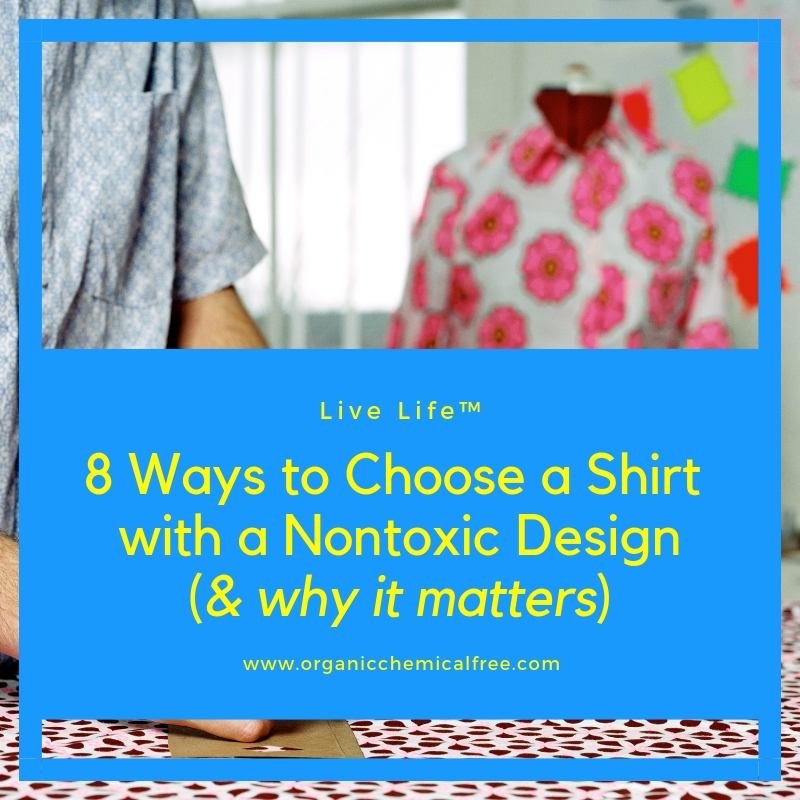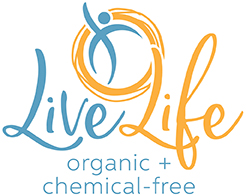
There are several factors to consider when choosing a nontoxic shirt. Shirt design is one of them.
What’s it made of? And is it affecting your health?
Want to know which shirt designs could be affecting health and 8 simple ways to choose a shirt with a nontoxic design? Keep reading!
What are Shirt Designs Made Of?
Shirt designs can be made of a variety of materials. Here are a few of the most popular ones.
- Vinyl
Shirt graphics and pictures can be made of a thin layer of vinyl. Vinyl allows for the design to flex so that the shirt follows your movements, bending when you bend.
How to know of your shirt has vinyl: If you run your fingers over the design and feel a texture change (a little roughness or drag) it indicates that vinyl may be present.
- Plastic
Plastic designs are often more rigid than vinyl. Therefore, designs made of plastic may stay in place when you bend forward instead of folding into your body.
How to know your shirt has plastic: Plastic designs are often raised. Typically, they’re thicker than vinyl and appear shiny.
- Synthetic dyes
Plaid and paisley designs are typically achieved by adding synthetic dyes. In addition to having the base- color dye, synthetic dyes are used to create patterns.
How to know if your shirt has synthetic dyes: Check the packaging or online description for the phrase “natural dye.” If it does not say that the dye is natural, it’s likely synthetic.
Is Your Shirt Design Affecting Health?
Vinyl, plastic and synthetic dyes are made of chemicals that may be causing numerous health conditions.
Vinyl
Chlorine, ethylene dichloride and phthalates are examples of the chemicals used to make vinyl.
The Ecology Center, Phthalates: Toxic Chemicals in Vinyl Plastic, states:
“Phthalate plasticizers are not chemically bound to vinyl, they can leach, migrate or evaporate into indoor air and concentrate in household dust.”
They go on to say, “Humans are exposed through ingestion, inhalation, and dermal exposure during their whole lifetimes.”
Among the health affects listed are: hormone-disruption, improper growth and development (including reproductive organ), obesity, altered behavior, and an increase in allergies and asthma.
Plastic
Bisphenol-A (BPA), bisphenol-S (BPS) and other BPA substitute chemicals are commonly used to make plastic.
BPA and substitute chemicals have been linked to: hormone disruption (which is linked to bunches of other health problems), cancer, infertility, and heart disease.
MadeSafe’s article, How to Avoid Toxic Chemicals in Plastics, mentions that BPA has been banned for baby bottles. However, that it’s likely still used in other plastics.
Further, substitute chemicals may be just as harmful to health. The MadeSafe article states:
“The bad news is that studies are showing that its replacement BPS, another chemical in the Bisphenol family, may be toxic as well, showing some of the same hormone-disrupting effects as BPA. In addition to BPA and BPS, studies show that plastics leech synthetic estrogen mimickers into the food or liquids stored inside them, which are linked to cancer, infertility, heart disease, and other health problems.”
Synthetic dyes
Two (of several) common chemicals used in synthetic dyes include toluene and benzene.
In a 2015 study, Advances in Understanding Benzene Health Effects and Susceptibility, the author stated:
“ It [benzene] is the primary starting material for chemicals used to make plastics, resins, synthetic fibers, dyes, detergents, drugs, and pesticides.”
Benzene has been linked to alteration of the immune system (illness defense), nervous system (brain, nerves), and hematological system (blood, bone marrow).
The World Health Organization’s International Programme on Chemical Safety page states,
“Human exposure to benzene has been associated with a range of acute and long term adverse health effects and diseases, including cancer and aplastic anaemia.”
Further, the American Cancer Society says this about benzene:
“IARC [International Agency for Research on Cancer] classifies benzene as “carcinogenic to humans,” based on sufficient evidence that benzene causes acute myeloid leukemia (AML). IARC also notes that benzene exposure has been linked with acute lymphocytic leukemia (ALL), chronic lymphocytic leukemia (CLL), multiple myeloma, and non-Hodgkin lymphoma.”
8 Ways to Choose a Shirt with a Nontoxic Design
1.Feel for a vinyl logo. Company logos, product slogans, and cute animals are added to adult and children’s clothing, often made of vinyl.
When you run your fingers over the shirt, you can feel a texture change and notice the extra thin layer on top of the fabric.
Vinyl, at room temperature, off-gasses chemicals into the air. This off-gassing is made worse when heat and moisture are added – the exact elements your shirt is exposed to when washing and drying clothes.
Choose shirts that are free of vinyl logos and designs, no matter how cute or trendy they may be.
2. Dyed-on designs. Plaid is all the rage right now. I’m flashing back to memories of plaid flannel shirts and paisley prints while writing this – lol.
Dyed-on designs may be less toxic than vinyl, especially when natural dyes are used.
3. Natural dyes on the label. Read the online description or shirt packaging and look for dyes described as “natural.”
Natural dyes are made with natural ingredients, most often plants or plant parts.
4. Embroidered logos. Wear company shirts that have an embroidered logo. Embroidery backing is often made of polyester that wears off during washing.
While polyester is a synthetic material, the small amount of poly gives an overall smaller chemical exposure than some other design options.
5. Without sequins. Made of flexible plastic, little sequins add bling to shirts but chemicals to the air.
Since plastic off-gasses, having it on your shirt and breathing it in all day long may not be the healthiest option.
Get your bling from a few 14k gold (or silver) necklaces that aren’t adding chemicals to the air you breathe.
6. Plastics are minimal. Rhinestone decorations (that are made of plastic, not stone) and raised pictures are two common places where plastic is used to decorate shirts.
Like vinyl, plastic off-gasses at normal room temperature and made worse by washing and drying clothes (from the heat and moisture).
Eliminate plastics as much as possible. One strategy is to choose shirt designs that do not have plastic.
7. Words are screen printed. Screen printing is achieved by adding more dye to the shirt, in a specific design.
Lettering that is dyed, especially with natural dyes, may have fewer chemicals than those with vinyl or plastic.
8. Other nontoxic designs.
- Patches
- Metal buttons or snaps
- Material layering (organic material, natural dyes, natural or no finishes)
Final Thoughts
A shirt’s design is an important factor to think about when choosing a nontoxic shirt.
However, it’s only one of several factors…one we don’t automatically think of when choosing clothing.
What other products have chemicals that we don’t typically think of?
Want to learn more ways to create the best organic, chemical free household?
